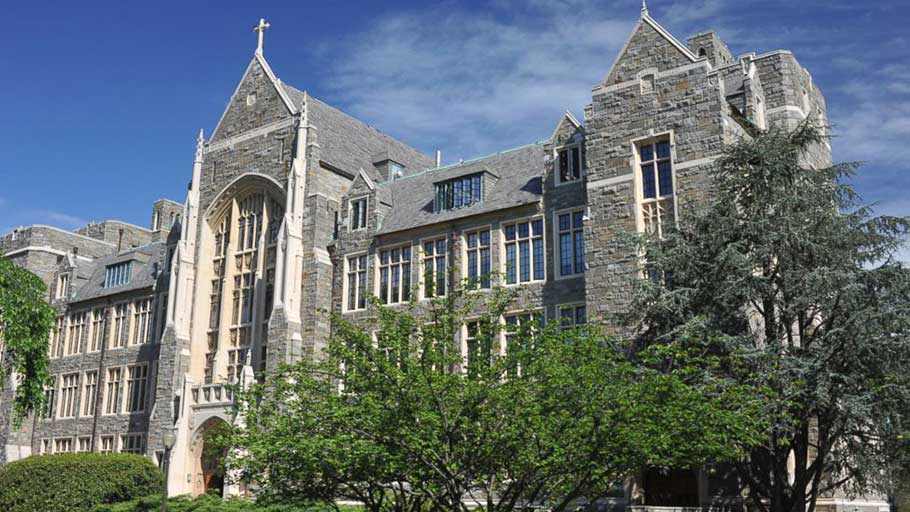A sixty-five-year-old student who is a descendant of slaves that the school once sold wants to make sure “the Jesuits atone for their sins.”
By Kitty Kelley, The New Yorker —
Mélisande Short-Colomb knows her begats. Three years ago, she received a Facebook message from a genealogist, asking if she was related to the Mahoney family of Baton Rouge. Like a Biblical scholar ticking off Old Testament lineage, she typed out a list of her forebears—enslaved and free—going back seven generations. The genealogist had struck gold. For months, she’d been searching for descendants of the roughly three hundred slaves who had been sold by the Maryland Jesuits who owned Georgetown College, in 1838, for a hundred and fifteen thousand dollars, to save the school from bankruptcy. With the help of Short-Colomb and her begats, more than eight thousand descendants of these slaves were located. Now Georgetown University is trying to make it up to them. Last month, the student body voted to pay reparations to the heirs.
Short-Colomb, who is sixty-five, with gray hair, is a rising junior at Georgetown. “I’m not just one of the oldest students here and one of the few African-Americans,” she said the other day. “I’m also part of the reconciliation program.” In 2016, the university began offering legacy status—a preference for admission, not a scholarship—to descendants of slaves owned by the Maryland Jesuits. One descendant has graduated, two are in graduate school, and three—including Short-Colomb—are undergraduates. “I’m here to help the Jesuits atone for their sins,” she said, smiling.
Short-Colomb was hanging out in her dorm, Copley Hall. Her room, which she calls her “tiny condo,” has a single bed, a large bathroom with grab rails, and a desk piled with papers, books, and a few crystals. She’s comfortable now, after what she calls the “trauma” of her first semester. “I was overwhelmed by everything that the young white students seemed to take in stride, if not for granted,” she said. “The kids all had the same look—leggings, puffy jackets, athletic shoes, and ponytails.” Short-Colomb, who had worked as a chef for twenty-two years, was used to wearing a uniform. “I didn’t know how to dress for college,” she said. “I looked strange walking around in my blue suède pumps.” That day, she had on a sweatshirt, sandals, and ripped, wide-legged jeans.
Last year, her window looked out on the school’s Jesuit cemetery. She would sometimes end her day watching the sun set over it. “I took a perverse pleasure in having survived the struggle of my ancestors,” she said. “I looked out at those Jesuit tombstones and was unapologetically grateful that they are dead and I am alive.” She admitted feeling bitter when she sees the African-American groundskeepers, knowing that the university had built over the former burial sites of slaves. “No brothers weeding and mowing their grounds,” she said.
The university isn’t bound by the student referendum to pay reparations, but the board of directors is expected to consider the recommendation in June. If it votes in favor, a reconciliation fee of twenty-seven dollars and twenty cents will be added to each undergraduate’s tuition bill. Short-Colomb helped rally the votes. Standing in a grassy quad, she’d announced, into a megaphone, “The dollar amount, symbolic of the two hundred and seventy-two Jesuit slaves sold, is only one-tenth of one per cent of the average tuition per semester.”
The result of the student vote is controversial on campus. Some students say that the university should pay its own reparations rather than make students fund them. International students have objected to paying for a crime that they didn’t commit. To the skeptics, Short-Colomb responds, “You came here voluntarily, and you’ll leave with the prestige of a degree from an esteemed university that would not exist but for the enslaved people who built it.”
Later that day, Short-Colomb cooked a gumbo dinner for her friend Richard Cellini, the founder of the Georgetown Memory Project. Cellini’s venture, which receives no financial support from Georgetown, has identified eight thousand four hundred and twenty-five descendants, more than four thousand of whom are alive. He hopes to locate even more and reunite fifteen hundred families who were separated by the 1838 sale.
Cellini, who describes himself as a “mustard-seed Catholic,” said that he knew very little about slavery or African-American history until a couple of years ago, when students began protesting after a story about the Georgetown slave auction ran in the student paper. “I could not stop thinking about the families ripped apart by that sale whose names had been in the university archives for years,” he said. Ironically, written records exist only because the Jesuits insisted that their slaves be baptized.
“We’ll save your soul while we sell your ass,” Short-Colomb joked.
“History only answers the questions we ask,” Cellini said. “For more than a hundred and fifty years, no one from Georgetown or the Maryland Jesuits ever went looking for the people sold.”
For Short-Colomb, it comes back to the begats. “Knowing where you come from is the only way to know who you are,” she said.














